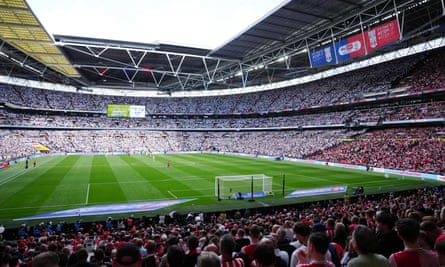The Wembley Stadium lasagne had one major design flaw, and it’s not the one you think. You may remember – right at the start of the pandemic – the Football Association being forced to deny a viral WhatsApp story that the stadium was being used to bake a giant lasagne to feed a hungry nation. And no, if you gave it even a moment’s consideration, the undersoil pitch heating probably wouldn’t have been strong enough to recreate oven conditions. That’s before you even get to the issue of the roof not being fully retractable.
But let’s assume, for the sake of argument, that we could surmount these technical obstacles and get the thing cooked. Let’s imagine our national stadium is now a delicious, bubbling mess of layered pasta sheets, ragu, bechamel and melted cheese. Now to divide the thing up and get it to those who need it most. And this – hypothetically speaking – is where the problems begin.
Because inevitably the thousands of Club Wembley VIPs – whose corporate memberships essentially fund the stadium – would demand their own priority lasagne access period. Bigger, luxury-sized portions. First refusal on the corner bits, where the cheese is at its crispiest. By the time Club Wembley had eaten their fill, the lasagne would almost have lost all structural integrity, the filling squeezed out, the pasta limp and chewy. The fast‑track lasagne lane would, like the PPE scandal, have been one of the biggest institutional injustices of the Covid era. Probably best they shelved it, to be honest.
But then Wembley has always been something of a microcosm for England as a whole: a place long since parcelled up and nibbled away and sold off to the highest bidder, while maintaining the pretence that it is, in fact, for everyone. A place so preoccupied with telling people of its greatness that it essentially passes into unchallenged fact. “The most iconic football stadium on the planet, the home of football, full stop,” announces the new Netflix documentary about the Euro 2020 final. OK. So that’s sorted then.
And you join us right in the thick of Wembley Season: those heady few weeks in April and May when summer is breaking, the big prizes are on the line and every man, woman and child possesses a selfie from the top of the steps at Wembley Park station. Both men’s FA Cup semi-finals, the men’s and women’s finals, four promotion playoff finals, non-league trophies, and this weekend the Champions League final between Borussia Dortmund and Real Madrid. Wembley is everywhere, and everywhere is Wembley. Which seems an appropriate moment to ask if it’s actually – you know – any good.
The troubled genesis of the new Wembley – the spiralling costs, the political gridlock, the endless delays – is well known, and yet feels less relevant these days. The FA repaid the final tranche of stadium debt last year, post‑Covid revenues are rebounding strongly and with a growing portfolio of non-footballing events from Taylor Swift to pro wrestling, Wembley is the rarest of things: a big public infrastructure project that has actually paid for itself.

Well, sort of. Because there are all kinds of other intangibles to consider here. Wembley likes to boast of the £70m of transport improvements that “benefit local residents all year round”. But of course these local residents are not all who they were. In the last decade the skies around Wembley have been blotted out by a forest canopy of swish apartment blocks, luxury developments, new hotels, high-end retail. A reminder, perhaps, that few in this country seem to possess a vision for growth and regeneration beyond “move some richer people in”.
And these issues are intrinsically linked to the sport itself. The very scale and cost of the Wembley project demanded a stadium stuffed with wall-to-wall content, a space that sweated its every last square foot for commercial potential. This is why, with its impersonal sheen, overbearing security, corporate hubbub and eye‑watering prices, Wembley feels less like a footballing pilgrimage and more like a shopping mall that secretly hates you.
This is why every men’s FA Cup semi-final is at Wembley, and that’s just the way it is, forever. Along with pretty much every England game in perpetuity, starving other regions of that same investment and prestige and revenue. Imagine what else Sport England could have done with the £120m grant it gave to Wembley (on the proviso it also hosted athletics, a pledge that was later quietly scrapped).
after newsletter promotion
Jim Ratcliffe wants to use public money to turn Old Trafford and the surrounding area into a Wembley of the North, just the latest entrepreneur set on making Manchester as unequal as London, while disguising the whole enterprise as “levelling up”. And frankly, why stop there? We need a Wembley of the Midlands, a Wembley of the Cotswolds, a Wembley of the Broads. The future is a panoply of Wembleys marching across the land, each with its own branch of Franco Manca and Las Iguanas, each with its own trickle of low‑paid catering and security jobs, and only by these stigmata will we truly know how blessed we are.
Of course, there is a paradox at the heart of the Wembley model. The more thinly it spreads itself, the more bases it tries to cover, the less special it becomes, forcing itself to spread thinner still, become yet more exclusive. The FA’s operating profit dropped by £100m last year, largely as a result of falling broadcast revenues, and so Club Wembley – with its special entrances and VIP lasagne lane – has become an even more crucial part of the operation.
A stadium itself has no meaning, no intrinsic cultural value. Only people can provide that. But when those people essentially become footfall, market share, an asset to be sweated, then the whole experience is devalued. After the carnage of Paris in 2022 and the chaos of Istanbul in 2023, welcome to the corporate nirvana of Wembley in 2024, where 27,000 VIPs and sponsors’ guests will enjoy the noise made by everyone else. In this respect, and others, Wembley offers a pretty decent parable for where the game as a whole is heading.
Source: theguardian.com


